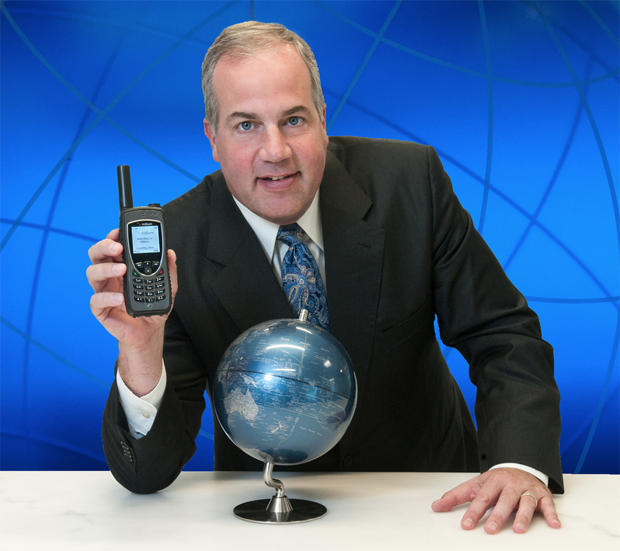Iridium poised to upgrade satellite telephone fleet
Iridium Communications is finally set for its initial launch of 10 next-generation satellites aboard a SpaceX Falcon 9 rocket Saturday, the first batch in a $3 billion 72-satellite network that will replace the company’s current fleet of aging low-Earth-orbit mobile voice and data relay stations.
The planned launching comes four-and-a-half months after a Falcon 9 rocket exploded on the pad in Cape Canaveral during a pre-flight test Sept. 1 that destroyed the booster, a $200 million communications satellite and heavily damaged the launch pad. The spectacular failure was blamed on a high-pressure helium tank in the rocket’s second stage that likely ruptured due to temperature-related issues.
SpaceX engineers have identified the most likely cause of the mishap and have implemented corrective actions. The company’s return to flight -- and launch of the first batch of Iridium NEXT satellites -- is targeted for 9:54:39 a.m. PST (GMT-8; 12:54 p.m. EST) Saturday from complex 4-East at Vandenberg Air Force Base, California.
The stakes are high for both companies.
For SpaceX, which has now lost two of 29 Falcon 9 rockets -- one in flight and one on the ground -- a successful mission will help restore confidence in the low-cost boosters and clear the way for a resumption of commercial and government launches that have been on hold since the September mishap.
“This will be a tough flight for us coming back after our event on Sept.1,” Gwynne Shotwell, SpaceX president and CEO, told “CBS This Morning.” “It is actually a difficult flight, regardless of the return-to-flight element.”
For Iridium, the launch Saturday is the first step in a complex satellite-by-satellite swap out, part of a long-range effort to retire satellites that have operated long past their design life, replace them with upgraded, more capable spacecraft and expand the company’s capabilities in an increasingly competitive commercial space operations environment.
“Frankly, it means our future, because we have to replace this network anyway,” Iridium CEO Matthew Desch said in an interview with CBS News before the Sept. 1 Falcon mishap. “I often think of it as one of the biggest tech refreshes in the world right now, with a new $3 billion constellation.”
All together, Iridium is paying SpaceX upwards of $500 million for seven Falcon 9 launches to boost 70 Iridium NEXT satellites into orbit, 10 at a time. Two more will be launched aboard a different rocket.
“Iridium’s a great customer, we’ve been working with them for, my goodness, six years so far,” Shotwell said. “We have six more launches after this with 10 satellites each. So we’ll basically be putting those 70 satellites into orbit, and that will form a network, a data network for the Iridium customers.”
Going into the long replacement operation, Desch said the first order of business is “to do no harm to our 800-and-some-thousand current subscribers. So the new satellites do everything the old satellites did, but they do a whole lot more. It really gets us seriously into sort of broadband connections.”
Iridium currently operates a fleet of 66 operational satellites, along with spares, in six orbital planes at an altitude of 483 miles.
With each satellite able to communicate with up to four others -- one ahead, one behind and one to either side in adjacent orbital planes -- the Iridium system provides a global communications network that includes hand-held phones, machine-to-machine devices and ship- and aircraft-born data transmitters.
Thanks to software upgrades implemented well after launch, the first-generation satellites can relay voice and data at ISDN-class speeds, but the Iridium NEXT spacecraft will work at up to 1.4 megabits per second. While that might not impress a modern smartphone user, “when you’re in the middle of nowhere, or the cockpit of an airplane or you’re on a ship, that’s going to be a whole lot more performance,” Desch said.
The new spacecraft also will carry circuitry provided by Harris Corp. to track ships at sea on a minute-by-minute basis and another Harris-built device, provided by a multi-agency consortium known as Aireon, that will track aircraft anywhere in the world.
“Each of those (Aireon) payloads can relay the position of commercial airliners in seconds to air traffic controllers, allowing airplanes to go more direct routes and burn less fuel and fly higher, faster,” Desch said. “That’s kind of a billion-dollar business (that) has nothing to do, technically, with our core mission, but it’s complementary in that there’s no other satellite network in low-Earth orbit with inter-satellite links that could do that.”
Iridium NEXT satellites will play a major role in machine-to-machine data relay, he said, “connecting trucks, cars, pipelines, stuff like that. We’re the thing you go to if you’re outside cellphone coverage, which is 90 percent of the world.”
“Today, we do that with a really small, low-cost device that can connect into hundreds of thousands of things (and) that really expands dramatically with Iridium NEXT because we can now take those speeds up, even with a tiny little low-cost antenna, tens of dollars, say up to about 100 kilobits per second, which really kind of changes the game there, too.”
The Falcon 9 carrying the first 10 Iridium NEXT satellites will release the spacecraft into a near-polar orbit tilted 86.4 degrees to the equator. They will all be in the same orbital plane, one of six used by the company to create its network.
The 1,896-pound solar-powered satellites, designed by the European aerospace giant Thales Alenia Space and mass produced assembly-line fashion by Orbital ATK in Arizona, each feature a phased-array antenna that can generate 48 beams over a footprint 3,000 miles across.
Each satellite also is equipped with high-speed links to ground stations and the required satellite-to-satellite cross links. It is those relay cross links that create a global network allowing users anywhere in the world to communicate cell phone fashion.
“The new satellites are a lot more powerful, a lot more processing power, they’ve got a lot more memory, a lot more capacity, they actually expand our ability to support customers,” Desch said. And, he added, “they’re easier to operate.”
Once the first two Iridium NEXT satellites are released from a custom dispenser atop the Falcon 9’s second stage, engineers will spend three months testing each one and carrying out a satellite-by-satellite swap out, moving a new spacecraft into position near the vehicle it’s replacing and switching service from one to the other.
“There will be a moment in time where literally the constellation will drop the links to the old satellite (and) re-establish links to the new satellite, this happens literally in microseconds,” Desch said. “If you were an ‘internet of things’ customer and you were tracking that oil and gas pipeline, you’d have one data transmission and then the next transmission would go through the NEXT satellite.”
The next set of 10 satellites is believed to be scheduled for launch in April.
While 66 satellites are needed to complete the Iridium NEXT network, the company plans to eventually launch 15 in-orbit spares. The additional satellites will provide immediate backup in case of an in-orbit malfunction and serve as an insurance policy of sorts in the event of a launch failure.
“That’s why we built 81 satellites,” Desch said. “We could have just paid more money to insurance companies and then when we lost (a launch) we would have gotten the satellite re-created. So we’re doing a bit of self insurance, if you will.”
That will cover a single launch failure. Iridium has more traditional insurance to cover the possibility of a second failure.
The original Iridium satellites eventually will be de-orbited to burn up in Earth’s atmosphere. And that will mark the end of an era for amateur satellite trackers who for years have enjoyed watching brilliant, easily seen and very predictable bursts of sunlight reflecting from a specific antenna on the first-generation satellites.
A variety of smartphone satellite tracking apps are available that tell users when Iridium “flares” will be visible from their location and flare watching has become a routine part of amateur satellite watching. But that will end with Iridium NEXT. The new satellites feature a different design, and flares are not expected.





